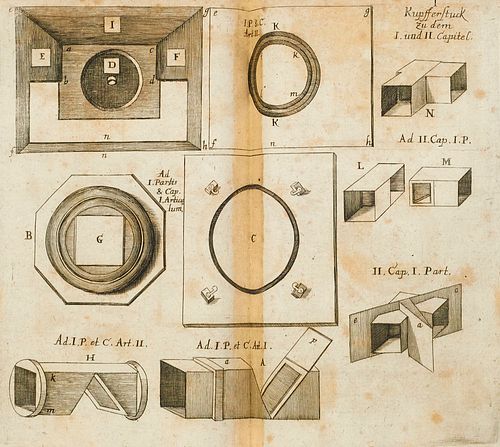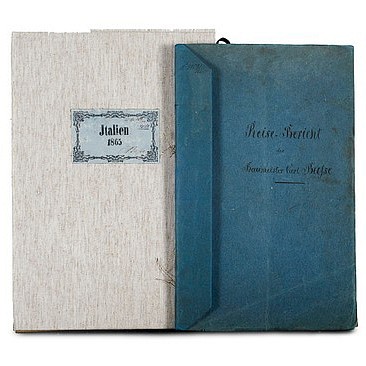Kohlhans, Johann Christoph Neu-erfundene mathematische und optische Curiositäten, bestehend so wohl in einem sattsamen Unterricht, zum Feldmessen und
Lot 1496
Categories
Absentee vs Live bid
Two ways to bid:
- Leave a max absentee bid and the platform will bid on your behalf up to your maximum bid during the live auction.
- Bid live during the auction and your bids will be submitted real-time to the auctioneer.
Bid Increments
| Price | Bid Increment |
|---|---|
| EUR€0 | EUR€10 |
| EUR€100 | EUR€10 |
| EUR€200 | EUR€20 |
| EUR€300 | EUR€30 |
| EUR€420 | EUR€30 |
| EUR€480 | EUR€20 |
| EUR€500 | EUR€50 |
| EUR€2,000 | EUR€200 |
| EUR€3,200 | EUR€300 |
About Auction
By Jeschke Jádi Auctions Berlin GmbH
Jul 31, 2021
Set Reminder
2021-07-31 06:00:00
2021-07-31 06:00:00
America/New_York
Bidsquare
Bidsquare : Rare Books, Prints, Historical Photography (Auction 138, Session 2)
https://www.bidsquare.com/auctions/jeschke-van-vliet/rare-books-prints-historical-photography-auction-138-session-2-7234
Session 2: Lot 882-1765 Jeschke Jádi Auctions Berlin GmbH info@jvv-berlin.de
Session 2: Lot 882-1765 Jeschke Jádi Auctions Berlin GmbH info@jvv-berlin.de
- Lot Description
Mathematik Kohlhans, Johann Christoph Neu-erfundene mathematische und optische Curiositäten, bestehend so wohl in einem sattsamen Unterricht, zum Feldmessen und itzt üblichen Fortification... als auch in einer gantz neuen und bewährten Art, allerhand ohne Rechnung mit geringer Mühe durch ein kleines Instrument genau und künstlich zu messen, und dann in beygefügten unterschiedlichen optischen Raritäten, auch andern zu Perspectiven und so genandter finstern Kammer gehörigen merckwürdigen Sachen. Mit 25 doppelblattgroßen Kupfertafeln. Leipzig, Lankisch und Jena, Nisius, 1677. 8 Bl., 320 S., 2 Bl. Gr.-8° Prgt. in Lwd.-Kasette. "Mathematics. - First edition with the first demonstrable description of a ""peep-box"" in the German-speaking world. - Johann Christoph Kohlhans (1604-1677) was appointed professor of mathematics and soon also of the Hebrew language at the Gymnasium Casimirianum in 1633. - Partly foxed and browned. - Bound with: as listed above. Copy from the library of Erwin Tomash. First complete edition. - Libri rari 52 - Cantor II, 693 - cf. DSB II, 419 and Poggendorff I, 274 - Part 1 was first published in 1634, Part 2 in 1647, the important third part with 21 plates here in the first printing. - Important work of the Hessian master builder and Campanella follower. Bramer was brother-in-law, pupil and colleague of Jost Bürgi, whom he followed to Prague in 1693. In 1612 Bramer was appointed master builder in Marburg by Moritz of Hesse. Later he moved to Ziegenhain as a pensioner and master builder. - Of particular importance for the history of mathematics is the third part, included here for the first time, in which Bramer describes the triangular instrument invented by his brother-in-law Bürgi. - The frontispiece with Bürgi's portrait is framed by mathematical instruments and allegories. The 21 beautiful copper plates of part 3 illustrate the use of the instrument in front of landscapes, towns and buildings, mostly with figurative staffage, but also mines and a map of the sky. - Somewhat stained and partly browned due to the paper, endpapers missing." "Erste Ausgabe mit der ersten im deutschen Sprachraum nachweisbaren Beschreibung eines ""Guck-Kastens"". - Poggendorff I, 1299. - Johann Christoph Kohlhans (1604-1677) wurde 1633 als Professor für Mathematik und bald auch für die hebräische Sprache an das Gymnasium Casimirianum berufen. - Teilweise stärker stockfleckig bzw. gebräunt. - Mitgebunden: Bramer, Benjamin. Apollonius Cattus, Oder, Kern der gantzen Geometriae in drey Theil. ... Nunmehr aber zum drittenmahl ... revidiret, verbessert und wieder auffgelegt. 3 Teile in 1 Band. Mit 1 gestochenem Frontispiz, 51 teilweise gefalteten Kupfertafeln sowie mehreren Holzschnitt-Figuren und Diagrammen. Marburg, J. H. Stock für J. Ingebrand in Kassel, 1684. - Exemplar aus der Bibliothek Erwin Tomash. Erste vollständige Ausgabe. - Libri rari 52 - Cantor II, 693 - vgl. DSB II, 419 und Poggendorff I, 274. - Teil 1 war erstmals 1634, Teil 2 1647 erschienen, der wichtige dritte Teil mit 21 Tafeln hier im Erstdruck. - Bedeutendes Werk des hessischen Baumeisters und Campanella-Anhängers. Bramer war Schwager, Zögling und Mitarbeiter von Jost Bürgi, dem er 1693 auch nach Prag folgte. 1612 wurde Bramer von Moritz von Hessen als Baumeister nach Marburg berufen. Später zog er als Rent- und Baumeister nach Ziegenhain. - Wichtig für die Geschichte der Mathematik ist vor allem der hier erstmals beigegebene dritte Teil, in dem Bramer das von seinem Schwager Bürgi erfundene Triangularinstrument beschreibt. - Das Frontispiz mit dem Porträt Bürgis umrahmt von mathematischen Instrumenten und Allegorien. Die 21 schönen Kupfertafeln zu Teil 3 illustrieren die Anwendung des Instrumentes vor Landschaften, Städten und Bauwerken, meist mit figürlicher Staffage, aber auch Bergwerke und eine Himmelskarte. - Etwas fleckig und papierbedingt teilweise gebräunt, Vorsatz fehlt." *
- Buyer's Premium



 EUR
EUR CAD
CAD AUD
AUD GBP
GBP MXN
MXN HKD
HKD CNY
CNY MYR
MYR SEK
SEK SGD
SGD CHF
CHF THB
THB











